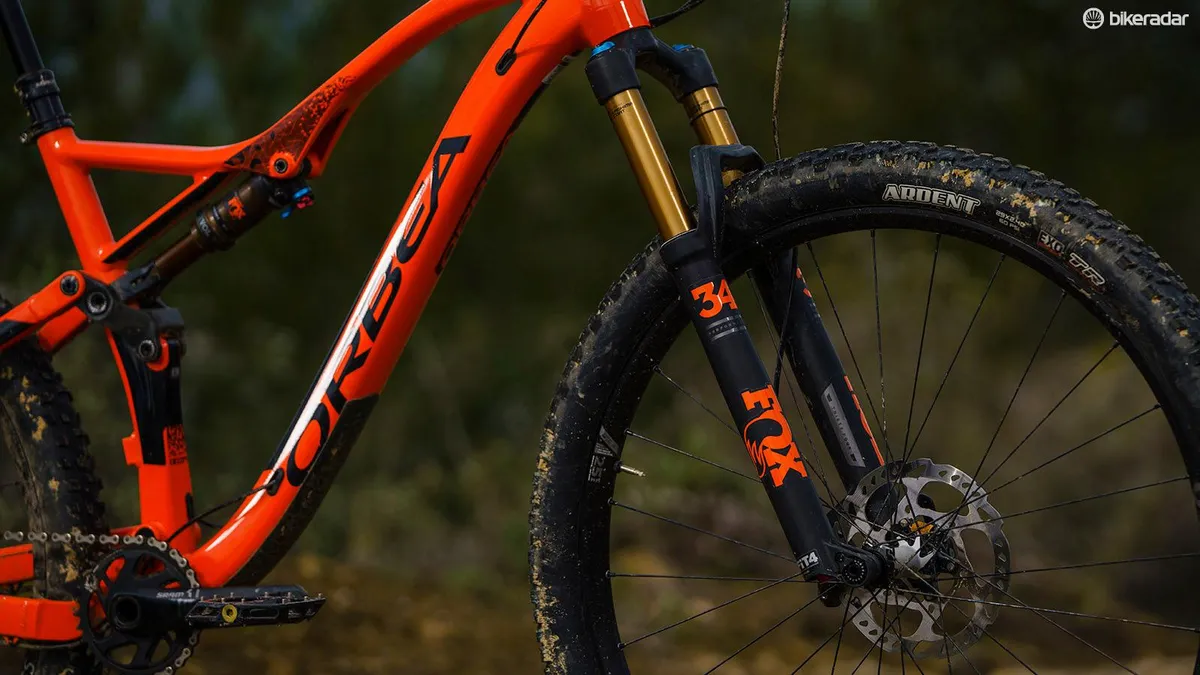The Orbea Occam TR is a trail bike that clearly has its DNA in XC bikes, making it an ideal partner for long days in the saddle where covering ground is as important as tackling the descents.
- The Orbea Orca M32 is one of our Bike of the Year bikes for 2018. To read reviews of the other contenders and the categories tested across road, mountain and women's bikes, visit our Bike of the Year hub.
Testing Bike of the Year 2018 contender the Orbea Occam TR H10
The 120mm of rear wheel suspension doesn’t give the bottomless feel of bigger bikes, nor a sofa-like feeling on steeper rough terrain, but has enough to tackle most of the trails that this bike is likely to be pointed at. Without too much travel it never feels bogged down by its travel either, making it a bike with a perky ride feel.
The suspension doesn’t wallow under power, certainly when seated. It can bob a touch when mashing on the pedals though, like pretty much any bike.
This tautness allows you to put the power down on flat yet rough trails and in combination with the 29in wheels makes for a fast bike when pedalling.

While it doesn’t sink into that mid-stroke when pedalling, the suspension is still active enough to enhance grip on technical climbs. If you’re a regular UK rider you might want to boost grip further by swapping the Maxxis Ardent/Forecaster tyres out for something grippier — especially up front.
However, for trail riders in drier conditions, the stock tyres should do you reasonably well until they wear out.

On less technical descents the relatively linear rear suspension lets the bike use its travel to the maximum, providing a comfortable, predictable and confident ride that encourages you to maintain speed.
This can lull you in to a false sense of security though should you wish to hit faster, bigger terrain. Without any added volume spacers in the shock the Orbea is prone to blowing through that travel too quick. I’d definitely want to add a volume spacer or two to the shock to provide ramp up at the end of the stroke for a little added security.
In more demanding conditions you also start to find the limits of the 130mm Fox 34s — there’s just that little bit too much fore-aft twang should you be looking for a bike on the more aggressive end of the trail bike spectrum.

My test bike came with the Factory Fit4 damped model (an optional £235/$319/€269 upgrade), which feels great on the trail. It’s smooth, doesn’t spike and the adjustable Fit 4 damper offers three genuinely useful compression positions (with a further 22 compression adjustments in the Open position).
The alloy frame is nicely finished, and manages to find the right balance between efficient stiffness and a touch of flex in the right places to help the tyres and wheels mould to the ground in off-camber sections.
The rear suspension design sits between a four-bar and a linkage actuated single pivot, with the rear triangle having a concentric pivot around the rear axle.
At just shy of 13.5kg the Occam TR isn’t light, but those with deeper pockets can save a bit by opting for carbon versions. Orbea doesn’t list weights on its site because it believes that there’s far more that goes in to the feel of a bike than its weight — something we agree with, to an extent.

Orbea hasn’t gone crazy with the geometry of the Occam, sitting between a traditional XC bike and a more descent-focussed trail bike. The head angle is 67.5 degrees and the seat angle is 74.
A reach of 450mm could be seen as conservative, but the 33mm bottom bracket drop allows you to sit in the bike rather than on it. The result is a bike that feels comfortable straight away, with few quirks to get used to in terms of handling.
That said, those looking for something a bit more ‘up to date’ should look elsewhere. The Occam isn’t exactly ‘traditional’ in its performance, but it also doesn’t stand out from the crowd as such.

While the stock Occam TR H10 comes in at £2,799 / $3,699 / €3,199 / AU$5,099, its online shop allows a degree of customisation before the bike is sent to your local dealer for the final build. This allows you to subtly change some parts and upcharge the spec.
Mine came with the aforementioned Factory Fox 34 fork, a Float Factory shock from Fox (additional £120/$169/€139) and DT’s M1700 Spline wheels (£175/$239/€199). There are also options on the brakes, dropper and cockpit.

With the trail bike spectrum being so wide, it’s fair to say that the Occam sits at the more XC side of things, but if you’re looking for an engaging, fun bike to ride day-long, then the Occam is a great partner.
Also consider...
If you're looking for alternative options, have a look at the following list. Each bike has been thoroughly tested and robustly reviewed. Click on the links for the full review.
- YT Jeffsy 29 CF
- Norco Sight A2 29
- Trek Fuel EX 8 29
- Canyon Spectral CF 9.0
- Marin B17 3
- Transition Scout NX
- Commencal Meda TR V4.2 Essential
- Santa Cruz Tallboy Alloy R
- Juliana Joplin R
- Specialized Rhyme Carbon Comp 6Fattie
- Canyon Spectral WMN CF 9.0 SL
- Yeti Beti SB5 C-Series XT
- Scott Contessa Spark 910
- BikeRadar would like to thank Life Cycle Adventures, Sanremo Bike Resort, MET Helmets and Bluegrass Eagle Protection for their help and support during our Bike of the Year testing.


